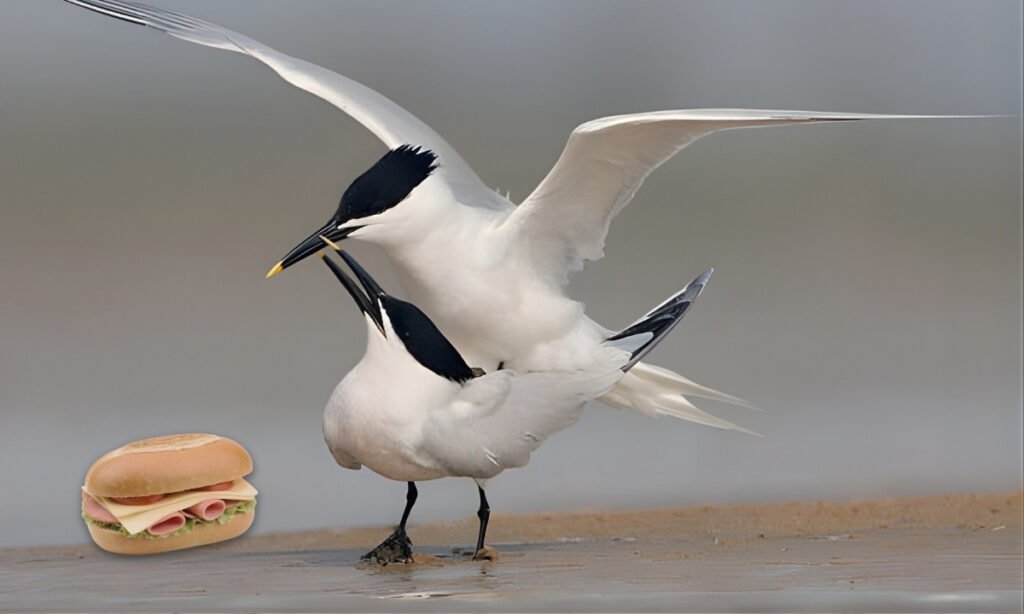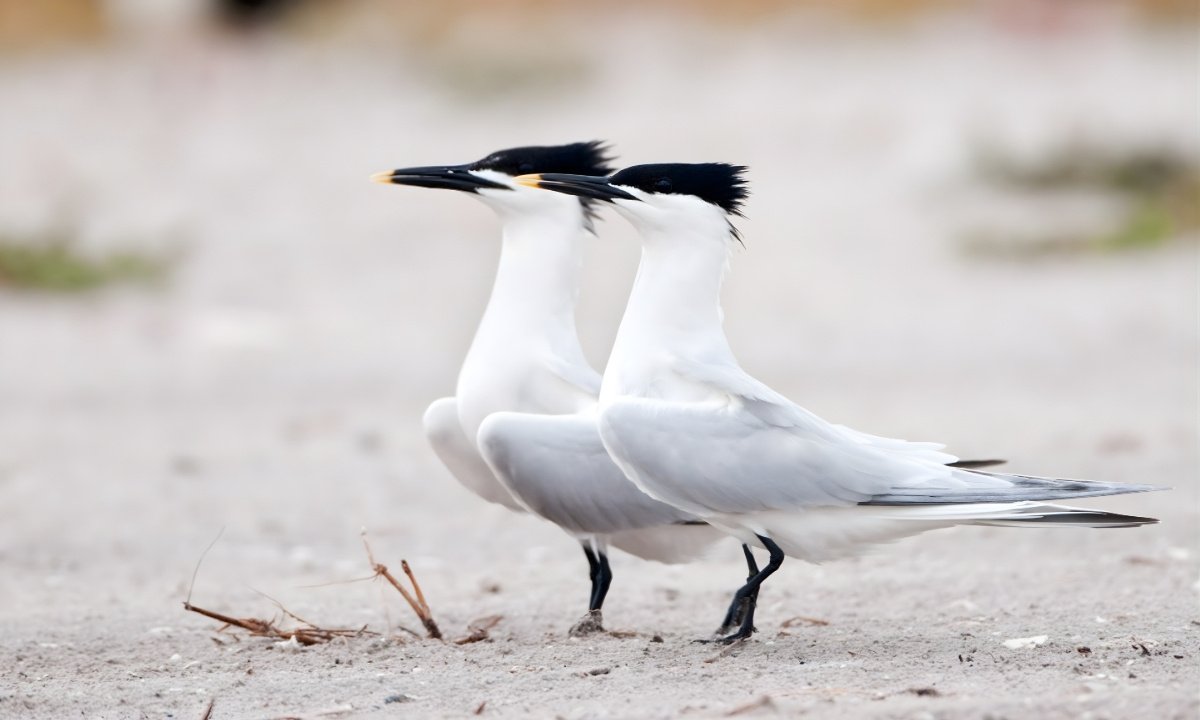The Sandwich Tern (Thalasseus sandvicensis) is a medium-large tern known for its black cap, long pointed wings, and distinctive black bill with a yellow tip. It breeds in Europe and travels to Africa in winter. The best way to recognize it is by its sharp “kirrick-kirrick” call and unique bill pattern, which separates it from the Common Tern.
 What Is a Sandwich Tern?
What Is a Sandwich Tern?
The Sandwich Tern (Thalasseus sandvicensis) is a striking seabird from the tern family.
Named after Sandwich, Kent (UK), it is not related to the food!
It lives in coastal colonies and dives for fish near the shore.
 Sandwich Tern Identification
Sandwich Tern Identification
Key Field Marks
| Feature | Description |
|---|---|
| Bill | Long, slender, black with a yellow tip |
| Cap | Shiny black crest in breeding season |
| Wings | Long, pointed; pale grey |
| Tail | Forked |
| Size | ~37–43 cm (14.5–17 in) |
| Weight | 180–300 g |
| Wingspan | 85–97 cm (33–38 in) |
Quick ID Tip:
When you see a tern with a black bill tipped yellow, you found a Sandwich Tern.
 Juvenile Sandwich Tern
Juvenile Sandwich Tern
Juveniles look more mottled and darker on top, with:
Brownish speckled back
Pale head with less black
Shorter crest
Bill may be dark without full yellow tip
 Winter Plumage
Winter Plumage
In winter, the Sandwich Tern’s black cap fades to a partial mask, leaving:
White forehead
Dark eye stripe
Shaggy crest remains but reduced
 Sandwich Tern vs Common Tern
Sandwich Tern vs Common Tern
| Feature | Sandwich Tern | Common Tern |
|---|---|---|
| Bill | Black w/ yellow tip | Red, black tip |
| Crest | Pronounced crest | Smooth head |
| Size | Larger | Smaller |
| Call | Harsh “kirrick” | Soft “kee-arr” |
| Plumage | Paler grey wings | Slightly darker |


 Behavior & Diet
Behavior & Diet
Diet
Primarily:
Small fish (sandeels, sprats)
Crustaceans occasionally
Feeding Behavior
Performs high plunging dives
Sometimes steals food (kleptoparasitism), often harassed by gulls
 Call & Sounds
Call & Sounds
The Sandwich Tern has a distinct call:
Sharp, raspy “kirrick-kirrick” or “keer-ik”
Often described as harsher than other terns.
 Range & Migration
Range & Migration
| Season | Location |
|---|---|
| Breeding | Europe, Black Sea, eastern North America (rare) |
| Winter | Africa, Persian Gulf, Caribbean |
Migration:
Long-distance migrant — from Northern Europe to West & South Africa.
 Breeding & Nesting
Breeding & Nesting
Nests in densely packed colonies
Prefers sandy islands & salt marshes
Lays 1–2 eggs
Both parents feed chicks
Chicks form crèches (nursery groups) for protection.
 Conservation Status
Conservation Status
IUCN Status: Least Concern
Threats:
Rising sea levels flooding nesting areas
Human disturbance
Pollution & overfishing
Conservation efforts include island protection & habitat restoration.
 Fun Facts
Fun Facts
Named after Sandwich, England, not the food!
One of the loudest tern colonies in Europe
Fluffy crested chicks resemble tiny punk rockers
 Visual ID Table
Visual ID Table
| Category | Key ID Feature |
|---|---|
| Bill | Black + yellow tip |
| Cap | Black crest (shaggy) |
| Flight | Fast, pointed wings, elegant |
| Plumage | White body, pale wings |
| Call | Harsh sharp “kirrick” |
 Frequently Asked Questions
Frequently Asked Questions
1. Why is it called a Sandwich Tern?
It was first described near Sandwich, Kent (England), not because it eats sandwiches or is sandwich-sized.
2. How do I identify a Sandwich Tern?
Look for:
Black bill with yellow tip
Black crest
Sharp call “kirrick”
Pale, elegant wings
3. Do Sandwich Terns migrate far?
Yes.
They migrate seasonally from northern Europe to Africa, traveling thousands of kilometers.
4. What is the main difference between Sandwich Tern and Common Tern?
The bill:
Sandwich Tern = black with yellow tip
Common Tern = red with black tip
5. What do Sandwich Terns eat?
Mainly small fish, caught via impressive diving flights.

If you enjoyed this guide and want to bring a touch of coastal bird charm into your daily routine, explore our watercolor “Stay calm and tern it into a sandwich” Sandwich Tern mug on Etsy — perfect for bird lovers, beach dreamers, and anyone who enjoys a little seabird humor with their coffee.


 What Is a Sandwich Tern?
What Is a Sandwich Tern?
 Sandwich Tern Identification
Sandwich Tern Identification Juvenile Sandwich Tern
Juvenile Sandwich Tern Winter Plumage
Winter Plumage
 Sandwich Tern vs
Sandwich Tern vs  Behavior & Diet
Behavior & Diet Call & Sounds
Call & Sounds
 Range & Migration
Range & Migration Breeding & Nesting
Breeding & Nesting Conservation Status
Conservation Status Fun Facts
Fun Facts Visual ID Table
Visual ID Table Frequently Asked Questions
Frequently Asked Questions
